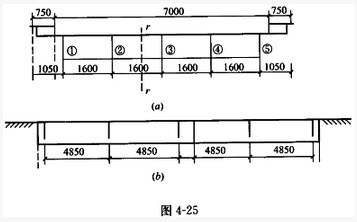问题
单项选择题
计算跨径L=19.5m的简支梁桥,其各主梁横向布置如图4-25(a)所示,各主梁间设有横隔梁,如图4-25B.。桥面净空为净-7+2×0.75m。汽车荷载为公路-Ⅱ级。汽车荷载冲击系数μ=0.30。提示:按《公路桥涵设计通用规范》(JTGD60-2004)及《公路钢筋混凝土及预应力混凝土桥涵设计规范》(JTGD62-2004)解答。
假定已求得汽车荷载F=130kN,已知按偏心受压法计算,1号主梁的跨中横向影响线的竖标值η=0.60,η=0.40,η=-0.20;2号主梁的跨中横向影响线的两个竖标值η=0.40,η=0.30;5号主梁的跨中横向影响线的竖标值η=-0.2,η=0,η=0.60。试问,梁桥跨中横隔梁在2号主梁、3号主梁之间的跨中r-r截面由汽车荷载产生的弯矩标准值M(kN·m),与下列何项数值最为接近()?
A.160
B.170
C.205
D.245
答案
参考答案:C
